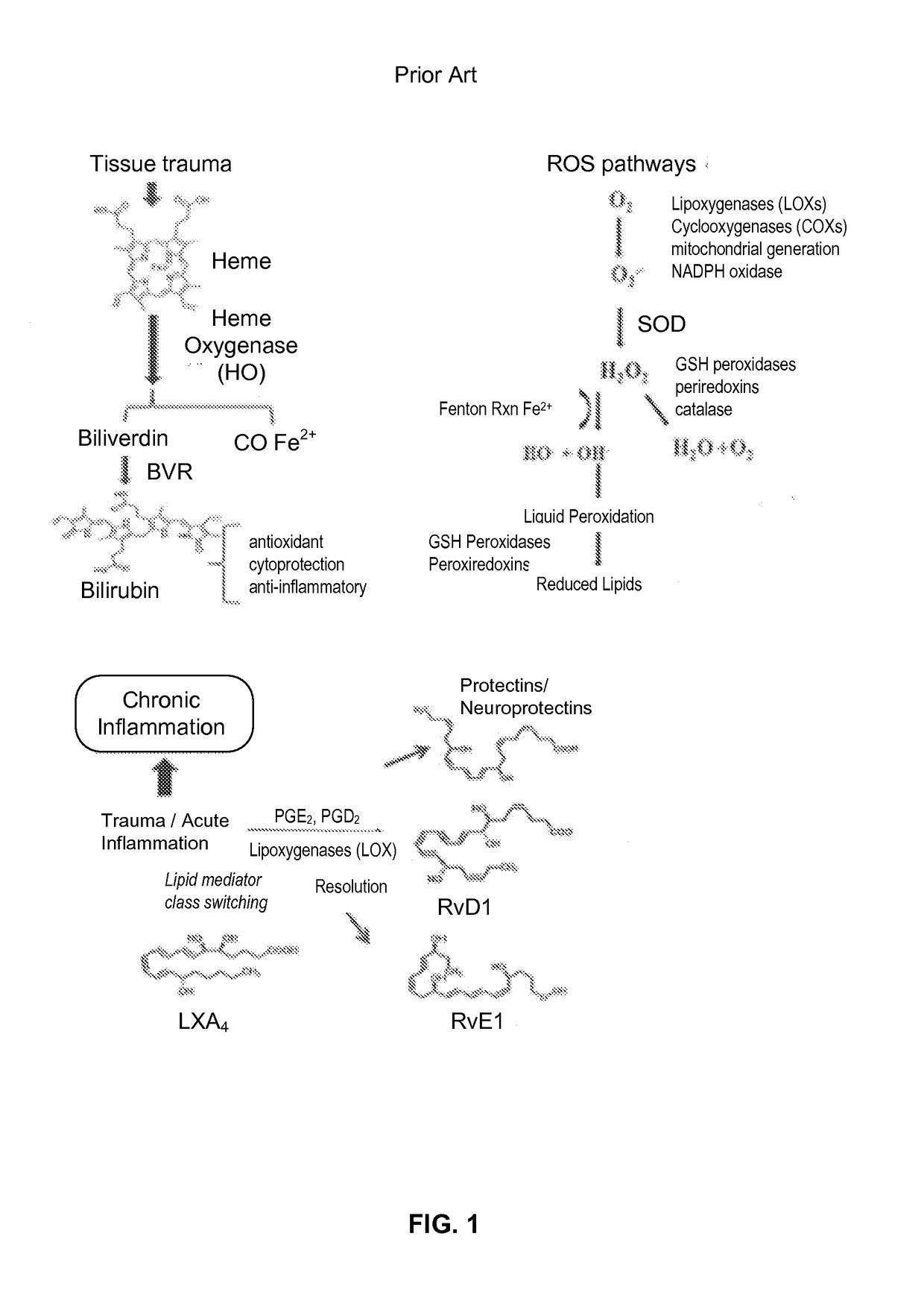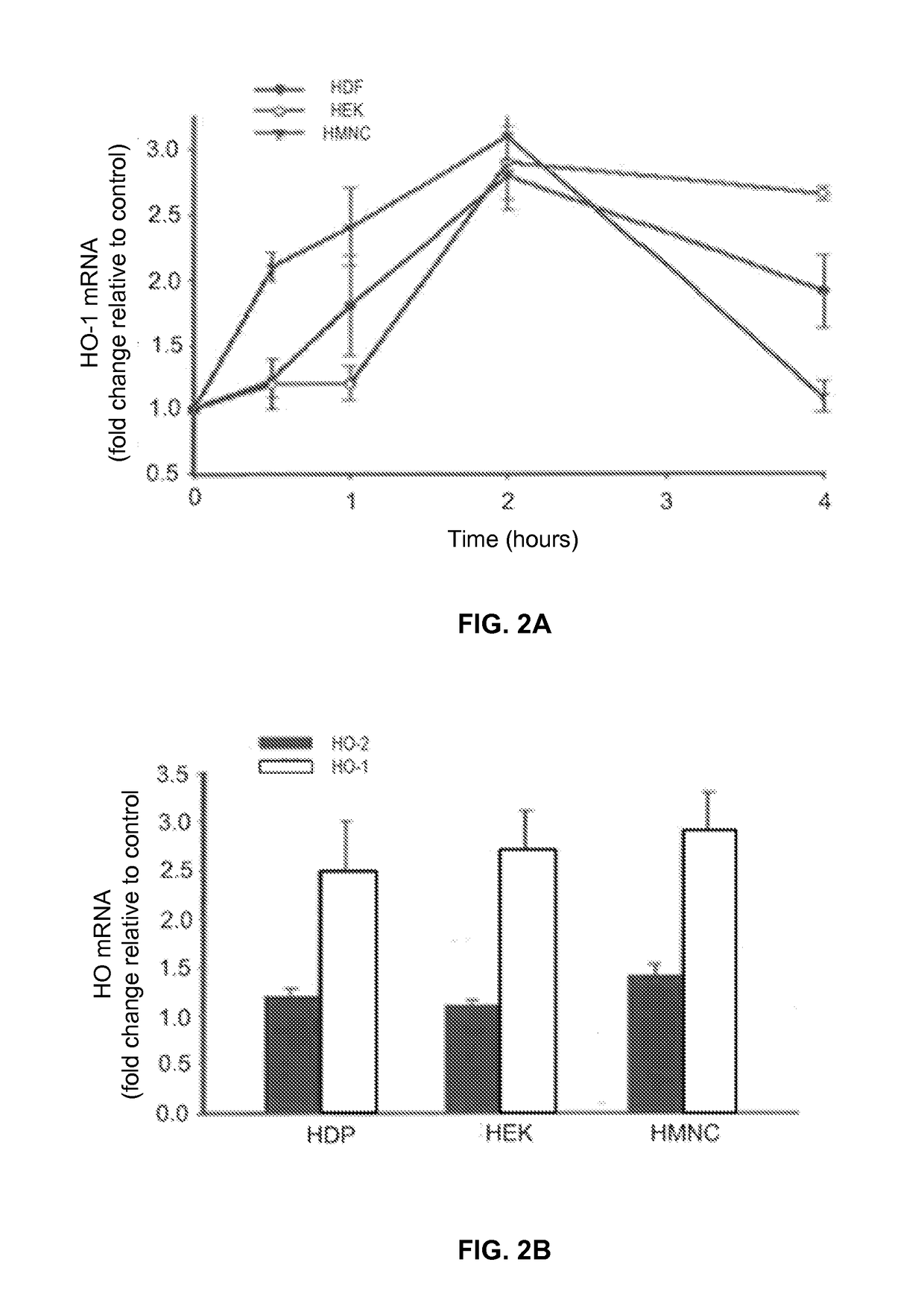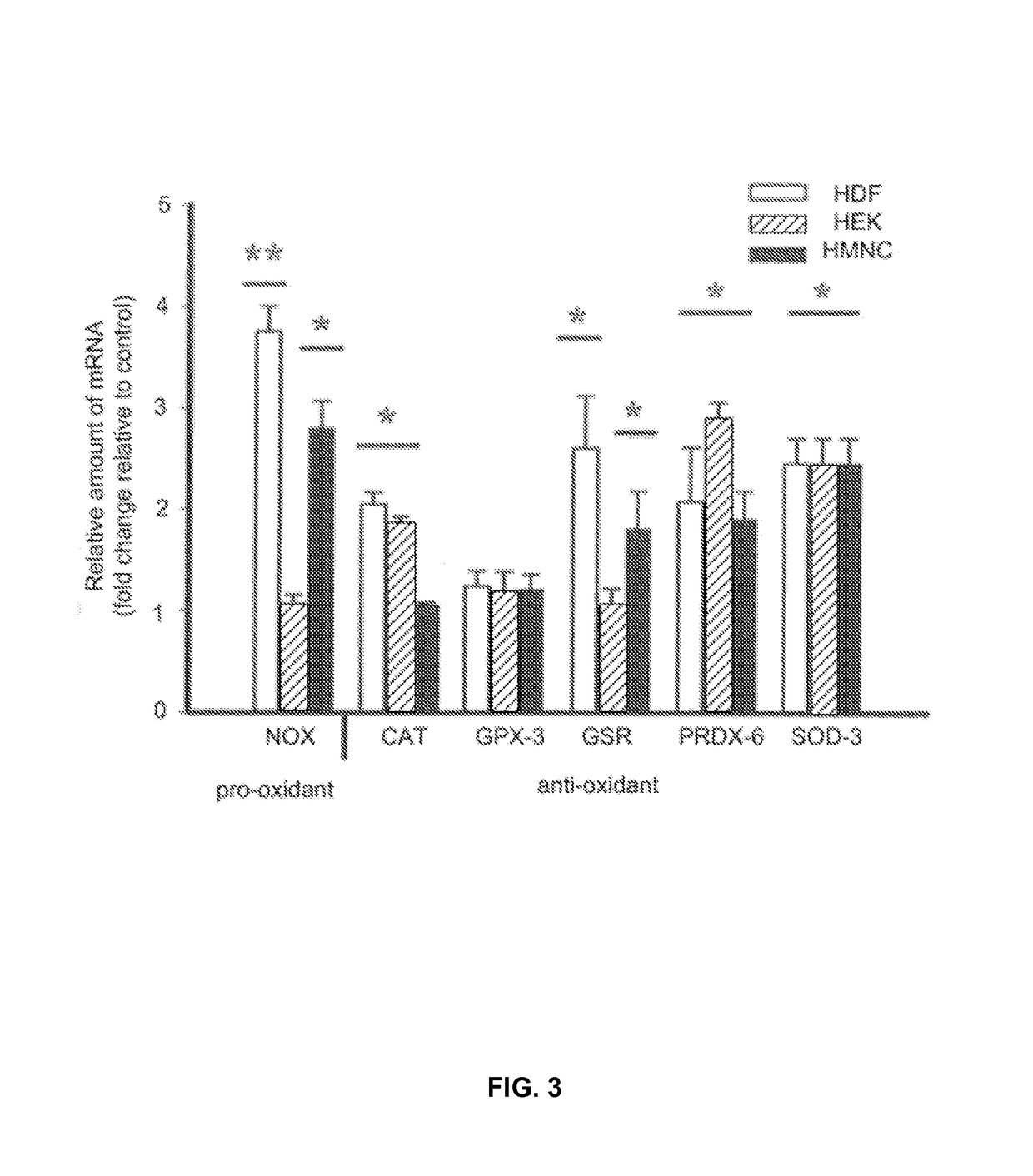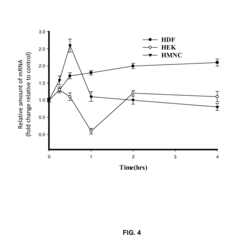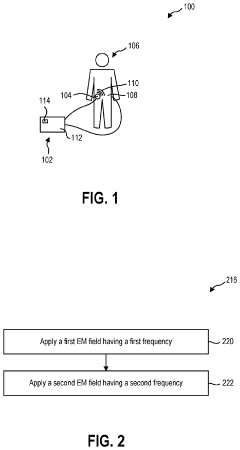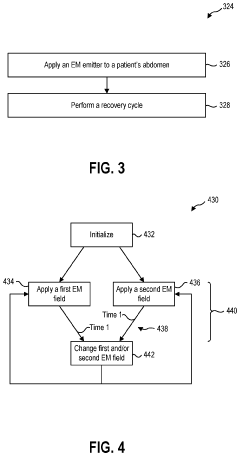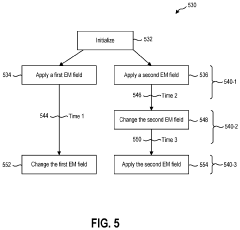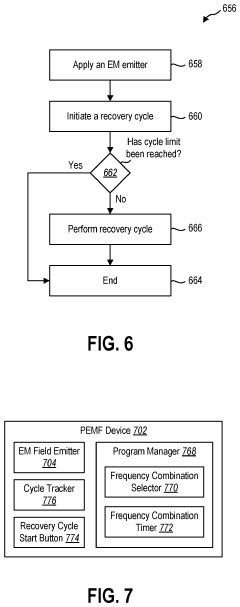How PEMF Therapy Enhances Post-Surgery Recovery?
AUG 11, 20259 MIN READ
Generate Your Research Report Instantly with AI Agent
Patsnap Eureka helps you evaluate technical feasibility & market potential.
PEMF Therapy Background and Objectives
Pulsed Electromagnetic Field (PEMF) therapy has emerged as a promising non-invasive treatment modality in recent years, particularly in the realm of post-surgical recovery. This technology harnesses the power of electromagnetic fields to stimulate cellular repair and regeneration, offering potential benefits for patients recovering from various surgical procedures.
The development of PEMF therapy can be traced back to the mid-20th century, with initial applications in bone healing. Over the decades, research has expanded its potential uses to include pain management, wound healing, and tissue regeneration. The evolution of PEMF technology has been driven by advancements in electromagnetic field generation and control, as well as a deeper understanding of cellular biology and biophysics.
In the context of post-surgery recovery, PEMF therapy aims to address several key challenges faced by patients and healthcare providers. These include managing pain, reducing inflammation, accelerating tissue repair, and minimizing the risk of complications. By targeting these aspects, PEMF therapy seeks to improve overall recovery outcomes and potentially reduce the duration of post-operative care.
The primary objective of PEMF therapy in post-surgical applications is to enhance the body's natural healing processes. This is achieved through the application of pulsed electromagnetic fields that interact with cellular structures and biochemical pathways. The therapy is designed to promote cellular regeneration, improve blood circulation, and modulate inflammatory responses, all of which are critical factors in the recovery process.
Recent technological advancements have led to the development of more sophisticated PEMF devices, allowing for precise control over field strength, frequency, and waveform. These innovations have expanded the potential applications of PEMF therapy and improved its efficacy in various medical contexts, including post-surgical recovery.
As research in this field progresses, there is a growing focus on optimizing PEMF protocols for specific surgical procedures and patient populations. This includes investigating the ideal treatment parameters, such as frequency and duration, to maximize therapeutic benefits while ensuring patient safety.
The integration of PEMF therapy into post-surgical care protocols represents a shift towards more holistic and patient-centered approaches to recovery. By addressing multiple aspects of the healing process simultaneously, PEMF therapy has the potential to complement traditional post-operative care methods and contribute to improved patient outcomes.
Looking ahead, the continued evolution of PEMF technology and its application in post-surgical recovery is expected to be driven by ongoing clinical research, technological innovations, and a growing emphasis on non-pharmacological interventions in healthcare. As our understanding of the underlying mechanisms deepens, PEMF therapy may become an increasingly important tool in enhancing post-surgery recovery and improving overall patient care.
The development of PEMF therapy can be traced back to the mid-20th century, with initial applications in bone healing. Over the decades, research has expanded its potential uses to include pain management, wound healing, and tissue regeneration. The evolution of PEMF technology has been driven by advancements in electromagnetic field generation and control, as well as a deeper understanding of cellular biology and biophysics.
In the context of post-surgery recovery, PEMF therapy aims to address several key challenges faced by patients and healthcare providers. These include managing pain, reducing inflammation, accelerating tissue repair, and minimizing the risk of complications. By targeting these aspects, PEMF therapy seeks to improve overall recovery outcomes and potentially reduce the duration of post-operative care.
The primary objective of PEMF therapy in post-surgical applications is to enhance the body's natural healing processes. This is achieved through the application of pulsed electromagnetic fields that interact with cellular structures and biochemical pathways. The therapy is designed to promote cellular regeneration, improve blood circulation, and modulate inflammatory responses, all of which are critical factors in the recovery process.
Recent technological advancements have led to the development of more sophisticated PEMF devices, allowing for precise control over field strength, frequency, and waveform. These innovations have expanded the potential applications of PEMF therapy and improved its efficacy in various medical contexts, including post-surgical recovery.
As research in this field progresses, there is a growing focus on optimizing PEMF protocols for specific surgical procedures and patient populations. This includes investigating the ideal treatment parameters, such as frequency and duration, to maximize therapeutic benefits while ensuring patient safety.
The integration of PEMF therapy into post-surgical care protocols represents a shift towards more holistic and patient-centered approaches to recovery. By addressing multiple aspects of the healing process simultaneously, PEMF therapy has the potential to complement traditional post-operative care methods and contribute to improved patient outcomes.
Looking ahead, the continued evolution of PEMF technology and its application in post-surgical recovery is expected to be driven by ongoing clinical research, technological innovations, and a growing emphasis on non-pharmacological interventions in healthcare. As our understanding of the underlying mechanisms deepens, PEMF therapy may become an increasingly important tool in enhancing post-surgery recovery and improving overall patient care.
Post-Surgery Recovery Market Analysis
The post-surgery recovery market has been experiencing significant growth in recent years, driven by an increasing number of surgical procedures worldwide and a growing emphasis on patient outcomes. This market encompasses a wide range of products and services designed to facilitate faster and more effective recovery after surgical interventions.
The global post-surgery recovery market is projected to reach substantial value in the coming years, with a compound annual growth rate (CAGR) that reflects the rising demand for advanced recovery solutions. Factors contributing to this growth include an aging population, advancements in surgical techniques, and a shift towards minimally invasive procedures that require specialized post-operative care.
Within this market, PEMF (Pulsed Electromagnetic Field) therapy has emerged as a promising technology for enhancing post-surgery recovery. The adoption of PEMF therapy in post-operative care is driven by its potential to reduce pain, inflammation, and promote tissue healing. As healthcare providers and patients seek non-pharmacological approaches to manage post-surgical complications, PEMF therapy has gained traction as a complementary treatment option.
The market for PEMF devices specifically tailored for post-surgery recovery is showing robust growth potential. These devices range from portable, home-use units to more sophisticated clinical systems used in healthcare facilities. The increasing acceptance of PEMF therapy among medical professionals and the growing body of clinical evidence supporting its efficacy are key drivers for market expansion.
Geographically, North America and Europe currently lead the post-surgery recovery market, including the adoption of PEMF therapy. However, emerging economies in Asia-Pacific and Latin America are expected to present significant growth opportunities due to improving healthcare infrastructure and rising healthcare expenditure.
Key market trends include the integration of PEMF technology with other recovery modalities, the development of smart, connected devices that allow for remote monitoring of patient progress, and the customization of treatment protocols for specific surgical procedures. Additionally, there is a growing focus on patient education and engagement, with manufacturers and healthcare providers working to increase awareness about the benefits of PEMF therapy in post-surgical care.
The competitive landscape of the post-surgery recovery market is characterized by a mix of established medical device companies and innovative startups specializing in PEMF technology. Strategic partnerships between PEMF device manufacturers and healthcare providers are becoming increasingly common, aimed at conducting clinical trials and establishing PEMF therapy as a standard component of post-operative care protocols.
The global post-surgery recovery market is projected to reach substantial value in the coming years, with a compound annual growth rate (CAGR) that reflects the rising demand for advanced recovery solutions. Factors contributing to this growth include an aging population, advancements in surgical techniques, and a shift towards minimally invasive procedures that require specialized post-operative care.
Within this market, PEMF (Pulsed Electromagnetic Field) therapy has emerged as a promising technology for enhancing post-surgery recovery. The adoption of PEMF therapy in post-operative care is driven by its potential to reduce pain, inflammation, and promote tissue healing. As healthcare providers and patients seek non-pharmacological approaches to manage post-surgical complications, PEMF therapy has gained traction as a complementary treatment option.
The market for PEMF devices specifically tailored for post-surgery recovery is showing robust growth potential. These devices range from portable, home-use units to more sophisticated clinical systems used in healthcare facilities. The increasing acceptance of PEMF therapy among medical professionals and the growing body of clinical evidence supporting its efficacy are key drivers for market expansion.
Geographically, North America and Europe currently lead the post-surgery recovery market, including the adoption of PEMF therapy. However, emerging economies in Asia-Pacific and Latin America are expected to present significant growth opportunities due to improving healthcare infrastructure and rising healthcare expenditure.
Key market trends include the integration of PEMF technology with other recovery modalities, the development of smart, connected devices that allow for remote monitoring of patient progress, and the customization of treatment protocols for specific surgical procedures. Additionally, there is a growing focus on patient education and engagement, with manufacturers and healthcare providers working to increase awareness about the benefits of PEMF therapy in post-surgical care.
The competitive landscape of the post-surgery recovery market is characterized by a mix of established medical device companies and innovative startups specializing in PEMF technology. Strategic partnerships between PEMF device manufacturers and healthcare providers are becoming increasingly common, aimed at conducting clinical trials and establishing PEMF therapy as a standard component of post-operative care protocols.
PEMF Technology Status and Challenges
Pulsed Electromagnetic Field (PEMF) therapy has gained significant attention in recent years for its potential to enhance post-surgery recovery. The current status of PEMF technology shows promising results in various medical applications, particularly in orthopedic and soft tissue healing. However, several challenges remain in fully realizing its potential and widespread adoption.
One of the primary challenges in PEMF technology is the lack of standardization in treatment protocols. Different devices use varying frequencies, intensities, and waveforms, making it difficult to compare results across studies and establish optimal treatment parameters. This inconsistency hinders the development of universally accepted guidelines for post-surgery applications.
Another significant challenge is the limited understanding of the precise mechanisms by which PEMF therapy influences cellular processes. While studies have shown positive effects on inflammation reduction, cell proliferation, and tissue regeneration, the exact pathways and long-term impacts are not fully elucidated. This gap in knowledge makes it challenging to optimize PEMF treatments for specific post-surgical conditions.
The current technology also faces limitations in terms of device design and usability. Many PEMF devices are bulky, requiring patients to remain stationary during treatment sessions. This can be inconvenient for post-surgery patients who need to balance recovery with mobility. Developing more compact, wearable PEMF devices that allow for continuous treatment during daily activities is an ongoing challenge.
Regulatory hurdles present another obstacle in the widespread adoption of PEMF therapy for post-surgery recovery. While some PEMF devices have received FDA approval for specific applications, the regulatory landscape remains complex, particularly for newer, more advanced devices. This can slow down the introduction of innovative PEMF technologies into clinical practice.
The cost-effectiveness of PEMF therapy is also a concern. High-quality PEMF devices can be expensive, and insurance coverage for this treatment modality is often limited. This financial barrier can restrict access to PEMF therapy for many patients, hindering its potential to become a standard post-surgery recovery tool.
Despite these challenges, PEMF technology continues to evolve. Recent advancements include the development of more targeted PEMF devices that can focus on specific body areas with greater precision. Additionally, research is ongoing to identify optimal treatment protocols for different types of surgeries and recovery phases.
In conclusion, while PEMF therapy shows great promise in enhancing post-surgery recovery, several technological and practical challenges need to be addressed. Overcoming these hurdles will be crucial in realizing the full potential of PEMF technology and establishing it as a mainstream treatment option in post-surgical care.
One of the primary challenges in PEMF technology is the lack of standardization in treatment protocols. Different devices use varying frequencies, intensities, and waveforms, making it difficult to compare results across studies and establish optimal treatment parameters. This inconsistency hinders the development of universally accepted guidelines for post-surgery applications.
Another significant challenge is the limited understanding of the precise mechanisms by which PEMF therapy influences cellular processes. While studies have shown positive effects on inflammation reduction, cell proliferation, and tissue regeneration, the exact pathways and long-term impacts are not fully elucidated. This gap in knowledge makes it challenging to optimize PEMF treatments for specific post-surgical conditions.
The current technology also faces limitations in terms of device design and usability. Many PEMF devices are bulky, requiring patients to remain stationary during treatment sessions. This can be inconvenient for post-surgery patients who need to balance recovery with mobility. Developing more compact, wearable PEMF devices that allow for continuous treatment during daily activities is an ongoing challenge.
Regulatory hurdles present another obstacle in the widespread adoption of PEMF therapy for post-surgery recovery. While some PEMF devices have received FDA approval for specific applications, the regulatory landscape remains complex, particularly for newer, more advanced devices. This can slow down the introduction of innovative PEMF technologies into clinical practice.
The cost-effectiveness of PEMF therapy is also a concern. High-quality PEMF devices can be expensive, and insurance coverage for this treatment modality is often limited. This financial barrier can restrict access to PEMF therapy for many patients, hindering its potential to become a standard post-surgery recovery tool.
Despite these challenges, PEMF technology continues to evolve. Recent advancements include the development of more targeted PEMF devices that can focus on specific body areas with greater precision. Additionally, research is ongoing to identify optimal treatment protocols for different types of surgeries and recovery phases.
In conclusion, while PEMF therapy shows great promise in enhancing post-surgery recovery, several technological and practical challenges need to be addressed. Overcoming these hurdles will be crucial in realizing the full potential of PEMF technology and establishing it as a mainstream treatment option in post-surgical care.
Current PEMF Post-Surgery Solutions
01 PEMF devices for therapeutic applications
Pulsed Electromagnetic Field (PEMF) therapy devices are designed for various therapeutic applications, including pain relief, tissue repair, and recovery enhancement. These devices generate electromagnetic fields that interact with the body's cells to promote healing and reduce inflammation.- PEMF devices for therapeutic applications: Pulsed Electromagnetic Field (PEMF) therapy devices are designed for various therapeutic applications, including pain relief, tissue repair, and overall recovery. These devices generate electromagnetic fields that interact with the body's cells to promote healing and reduce inflammation.
- PEMF therapy for muscle recovery and performance enhancement: PEMF therapy is utilized for muscle recovery and performance enhancement in athletes and fitness enthusiasts. The electromagnetic fields stimulate muscle tissue, improve blood circulation, and accelerate the removal of metabolic waste, leading to faster recovery times and improved athletic performance.
- Combination of PEMF with other therapeutic modalities: PEMF therapy is often combined with other therapeutic modalities to enhance overall recovery and treatment outcomes. This may include integration with heat therapy, cryotherapy, or other forms of electromagnetic stimulation to provide comprehensive healing and recovery solutions.
- Portable and wearable PEMF devices for continuous therapy: Advancements in PEMF technology have led to the development of portable and wearable devices that allow for continuous therapy throughout the day. These devices are designed to be compact, lightweight, and user-friendly, enabling patients to receive treatment while going about their daily activities.
- PEMF therapy for neurological recovery and brain health: PEMF therapy is being explored for its potential benefits in neurological recovery and brain health. Research suggests that electromagnetic fields may have neuroprotective effects, promote neuroplasticity, and aid in the recovery of brain injuries or neurological disorders.
02 PEMF therapy for muscle recovery and performance
PEMF therapy is utilized to enhance muscle recovery and improve athletic performance. The electromagnetic fields stimulate cellular activity, increase blood flow, and reduce muscle soreness, leading to faster recovery times and improved overall physical performance.Expand Specific Solutions03 Combination of PEMF with other therapies
PEMF therapy is often combined with other therapeutic modalities to enhance overall treatment effectiveness. This may include integration with heat therapy, cryotherapy, or other forms of electromagnetic stimulation to provide comprehensive recovery and healing solutions.Expand Specific Solutions04 Portable and wearable PEMF devices
Advancements in PEMF technology have led to the development of portable and wearable devices for convenient at-home or on-the-go therapy. These compact devices allow for continuous treatment and can be easily integrated into daily routines for ongoing recovery support.Expand Specific Solutions05 PEMF therapy for neurological recovery
PEMF therapy is being explored for its potential benefits in neurological recovery and brain health. The electromagnetic fields may help stimulate neural activity, promote neuroplasticity, and support recovery from various neurological conditions or injuries.Expand Specific Solutions
Key PEMF Device Manufacturers
The PEMF therapy market for post-surgery recovery is in a growth phase, with increasing adoption and expanding applications. The market size is projected to grow significantly due to rising awareness of non-invasive treatment options and the growing demand for faster recovery times. Technologically, PEMF therapy is advancing rapidly, with companies like Venus Concept Ltd., Regenesis Biomedical, Inc., and SofPulse, Inc. leading innovation. These firms are developing more sophisticated, targeted, and user-friendly PEMF devices. The technology's maturity is evident in its integration into various medical settings, from hospitals to home care, indicating a robust and competitive landscape with potential for further advancements and market expansion.
Venus Concept Ltd.
Technical Solution: Venus Concept has developed advanced PEMF therapy devices specifically designed for post-surgery recovery. Their technology utilizes precise electromagnetic pulses to stimulate cellular repair and reduce inflammation. The company's PEMF systems incorporate adjustable frequency and intensity settings, allowing for customized treatment protocols based on the specific surgical procedure and patient needs. Venus Concept's devices also feature built-in treatment programs targeting common post-surgical concerns such as pain management, edema reduction, and accelerated tissue healing[1][3]. The company has conducted clinical studies demonstrating significant improvements in recovery time and patient comfort compared to traditional post-operative care methods[2].
Strengths: Customizable treatment protocols, clinically proven efficacy, user-friendly interface. Weaknesses: Higher initial cost compared to some alternatives, requires proper training for optimal use.
Regenesis Biomedical, Inc.
Technical Solution: Regenesis Biomedical has pioneered a unique approach to PEMF therapy for post-surgery recovery with their Provant Therapy System. This FDA-cleared device utilizes a proprietary pulsed radio frequency energy (PRFE) technology, which is a specialized form of PEMF. The Provant system delivers non-thermal electromagnetic energy to the treatment area, promoting cellular regeneration and reducing inflammation. Regenesis' technology is designed to penetrate deeper into tissues compared to traditional PEMF devices, potentially offering more effective treatment for post-surgical recovery[4]. The company's devices are programmed with specific treatment protocols optimized for various surgical procedures, ensuring consistent and targeted therapy[5].
Strengths: Deep tissue penetration, FDA-cleared for multiple indications, portable design for home use. Weaknesses: May require longer treatment sessions compared to some competitors, limited adjustability of treatment parameters.
PEMF Therapy Core Mechanisms
Treatment of conditions susceptible to pulsed electromagnetic field therapy
PatentActiveUS20170354830A1
Innovation
- PEMF therapy is administered to modulate gene expression associated with inflammation pathways, including heme oxygenase, antioxidant enzymes, lipid mediator biosynthesis, and cytokines, using specific parameters such as electric field strength, pulse rate, and duration to produce measurable clinical effects on pain, nerve function, and wound healing.
Methods, systems, and devices for post-birth recovery
PatentPendingUS20220370818A1
Innovation
- A method involving a pulsed electromagnetic field (PEMF) device that applies specific frequency combinations and their associated periods to stimulate tissue healing responses, including stop bleeding, anesthesia removal, inflammation reduction, tissue repair, pain relief, and emotional recovery, using EM field emitters placed on the abdomen or back to target various organs and cell groups.
Clinical Trials and Efficacy Data
Numerous clinical trials have been conducted to evaluate the efficacy of Pulsed Electromagnetic Field (PEMF) therapy in enhancing post-surgery recovery. These studies have consistently demonstrated positive outcomes across various surgical procedures and patient populations.
A meta-analysis of randomized controlled trials published in the Journal of Orthopaedic Surgery and Research in 2018 examined the effects of PEMF therapy on postoperative pain and swelling following knee arthroplasty. The analysis, which included 11 studies with a total of 626 patients, found that PEMF therapy significantly reduced pain intensity and swelling compared to control groups.
Another comprehensive review published in the International Journal of Molecular Sciences in 2019 focused on the application of PEMF therapy in orthopedic surgery recovery. The review analyzed 31 clinical trials and reported that PEMF therapy consistently improved pain management, reduced inflammation, and accelerated tissue healing in patients undergoing various orthopedic procedures.
A randomized, double-blind, placebo-controlled study published in the Journal of Plastic and Reconstructive Surgery in 2020 investigated the effects of PEMF therapy on post-operative recovery following breast augmentation surgery. The study, involving 80 patients, reported significant improvements in pain scores, reduced analgesic consumption, and faster resolution of edema in the PEMF treatment group compared to the placebo group.
In the field of spinal surgery, a prospective, randomized clinical trial published in The Spine Journal in 2021 evaluated the efficacy of PEMF therapy in promoting fusion and reducing pain following lumbar spinal fusion surgery. The study, which included 120 patients, demonstrated that the PEMF group achieved higher fusion rates and reported lower pain scores at 6 and 12 months post-surgery compared to the control group.
Efficacy data from these clinical trials consistently show that PEMF therapy can significantly enhance post-surgery recovery across multiple parameters. Patients receiving PEMF therapy typically experience reduced pain intensity, decreased inflammation, accelerated wound healing, and improved functional outcomes compared to standard care alone.
However, it is important to note that while the majority of studies report positive outcomes, the optimal treatment protocols, including frequency, duration, and intensity of PEMF therapy, may vary depending on the specific surgical procedure and patient characteristics. Further research is ongoing to refine these protocols and establish standardized guidelines for the application of PEMF therapy in post-surgical care.
A meta-analysis of randomized controlled trials published in the Journal of Orthopaedic Surgery and Research in 2018 examined the effects of PEMF therapy on postoperative pain and swelling following knee arthroplasty. The analysis, which included 11 studies with a total of 626 patients, found that PEMF therapy significantly reduced pain intensity and swelling compared to control groups.
Another comprehensive review published in the International Journal of Molecular Sciences in 2019 focused on the application of PEMF therapy in orthopedic surgery recovery. The review analyzed 31 clinical trials and reported that PEMF therapy consistently improved pain management, reduced inflammation, and accelerated tissue healing in patients undergoing various orthopedic procedures.
A randomized, double-blind, placebo-controlled study published in the Journal of Plastic and Reconstructive Surgery in 2020 investigated the effects of PEMF therapy on post-operative recovery following breast augmentation surgery. The study, involving 80 patients, reported significant improvements in pain scores, reduced analgesic consumption, and faster resolution of edema in the PEMF treatment group compared to the placebo group.
In the field of spinal surgery, a prospective, randomized clinical trial published in The Spine Journal in 2021 evaluated the efficacy of PEMF therapy in promoting fusion and reducing pain following lumbar spinal fusion surgery. The study, which included 120 patients, demonstrated that the PEMF group achieved higher fusion rates and reported lower pain scores at 6 and 12 months post-surgery compared to the control group.
Efficacy data from these clinical trials consistently show that PEMF therapy can significantly enhance post-surgery recovery across multiple parameters. Patients receiving PEMF therapy typically experience reduced pain intensity, decreased inflammation, accelerated wound healing, and improved functional outcomes compared to standard care alone.
However, it is important to note that while the majority of studies report positive outcomes, the optimal treatment protocols, including frequency, duration, and intensity of PEMF therapy, may vary depending on the specific surgical procedure and patient characteristics. Further research is ongoing to refine these protocols and establish standardized guidelines for the application of PEMF therapy in post-surgical care.
Regulatory Framework for PEMF Devices
The regulatory framework for PEMF (Pulsed Electromagnetic Field) devices plays a crucial role in ensuring the safety and efficacy of these devices in post-surgery recovery applications. In the United States, the Food and Drug Administration (FDA) oversees the regulation of PEMF devices, classifying them as Class II medical devices. This classification requires manufacturers to submit a 510(k) premarket notification, demonstrating that their device is substantially equivalent to a legally marketed predicate device in terms of safety and effectiveness.
The FDA has established specific guidelines for PEMF devices, including requirements for electromagnetic compatibility, electrical safety, and biocompatibility. Manufacturers must provide clinical data supporting the device's intended use and demonstrate compliance with quality system regulations. Additionally, the FDA mandates that PEMF devices meet certain labeling requirements, clearly stating their intended use and any potential risks associated with their use.
In the European Union, PEMF devices fall under the Medical Device Regulation (MDR), which came into effect in May 2021. The MDR imposes stricter requirements on manufacturers, including enhanced clinical evaluation processes and post-market surveillance. PEMF devices must obtain CE marking to be sold in the EU market, indicating compliance with all applicable EU health, safety, and environmental protection legislation.
Japan's Pharmaceuticals and Medical Devices Agency (PMDA) regulates PEMF devices under the Pharmaceutical and Medical Device Act. The approval process involves submitting technical documentation, clinical data, and quality management system certifications. Similarly, Health Canada classifies PEMF devices as Class II medical devices, requiring manufacturers to obtain a Medical Device License before marketing their products.
International standards, such as IEC 60601-1 for medical electrical equipment safety and IEC 60601-1-2 for electromagnetic compatibility, are widely recognized and often incorporated into national regulatory frameworks. Compliance with these standards is typically necessary for obtaining regulatory approval in various jurisdictions.
As the use of PEMF therapy in post-surgery recovery gains more attention, regulatory bodies are continually updating their frameworks to address emerging technologies and applications. This includes considerations for combination products that integrate PEMF technology with other medical devices or pharmaceuticals, as well as guidelines for software-controlled PEMF devices and mobile applications used in conjunction with these devices.
Manufacturers and healthcare providers must stay informed about the evolving regulatory landscape to ensure compliance and maintain patient safety. This includes adhering to post-market surveillance requirements, reporting adverse events, and implementing necessary updates or recalls as directed by regulatory authorities.
The FDA has established specific guidelines for PEMF devices, including requirements for electromagnetic compatibility, electrical safety, and biocompatibility. Manufacturers must provide clinical data supporting the device's intended use and demonstrate compliance with quality system regulations. Additionally, the FDA mandates that PEMF devices meet certain labeling requirements, clearly stating their intended use and any potential risks associated with their use.
In the European Union, PEMF devices fall under the Medical Device Regulation (MDR), which came into effect in May 2021. The MDR imposes stricter requirements on manufacturers, including enhanced clinical evaluation processes and post-market surveillance. PEMF devices must obtain CE marking to be sold in the EU market, indicating compliance with all applicable EU health, safety, and environmental protection legislation.
Japan's Pharmaceuticals and Medical Devices Agency (PMDA) regulates PEMF devices under the Pharmaceutical and Medical Device Act. The approval process involves submitting technical documentation, clinical data, and quality management system certifications. Similarly, Health Canada classifies PEMF devices as Class II medical devices, requiring manufacturers to obtain a Medical Device License before marketing their products.
International standards, such as IEC 60601-1 for medical electrical equipment safety and IEC 60601-1-2 for electromagnetic compatibility, are widely recognized and often incorporated into national regulatory frameworks. Compliance with these standards is typically necessary for obtaining regulatory approval in various jurisdictions.
As the use of PEMF therapy in post-surgery recovery gains more attention, regulatory bodies are continually updating their frameworks to address emerging technologies and applications. This includes considerations for combination products that integrate PEMF technology with other medical devices or pharmaceuticals, as well as guidelines for software-controlled PEMF devices and mobile applications used in conjunction with these devices.
Manufacturers and healthcare providers must stay informed about the evolving regulatory landscape to ensure compliance and maintain patient safety. This includes adhering to post-market surveillance requirements, reporting adverse events, and implementing necessary updates or recalls as directed by regulatory authorities.
Unlock deeper insights with Patsnap Eureka Quick Research — get a full tech report to explore trends and direct your research. Try now!
Generate Your Research Report Instantly with AI Agent
Supercharge your innovation with Patsnap Eureka AI Agent Platform!
